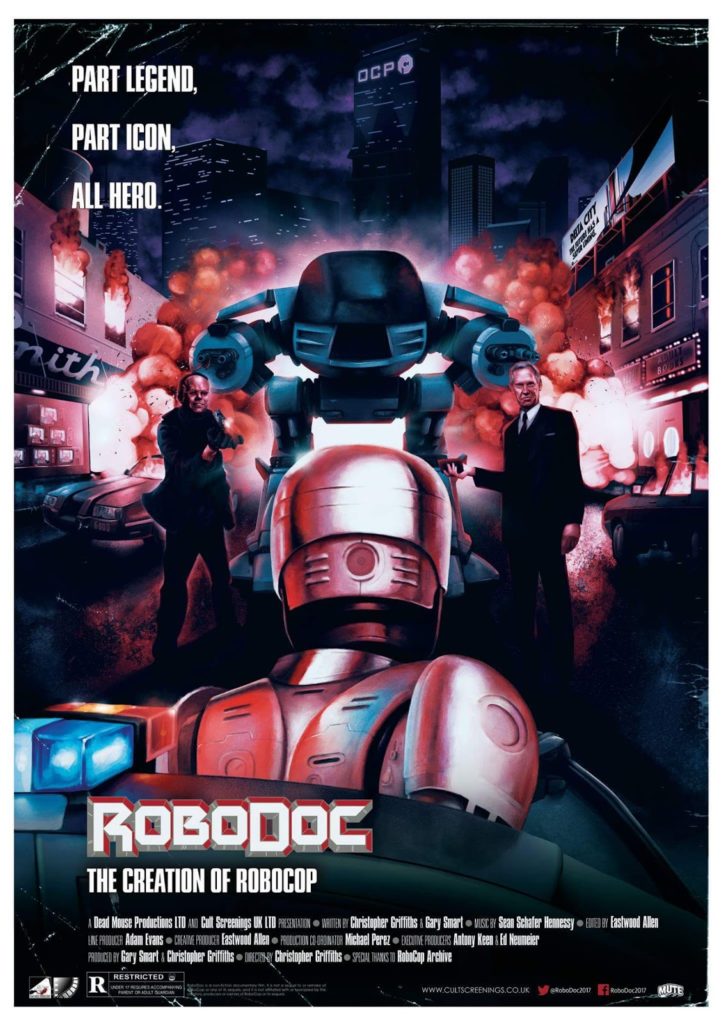
“Dead or alive, you’re coming with me.” That’s what ROBODOC’s Kickstarter said to wallets worldwide the second it went live. Currently in post-production, it’s the latest documentary from Cult Screenings UK about that other 80s cop from Detroit. ROBOCOP was the combination of ideas from Michael Miner and Ed Neumeier (one being inspired by BLADE RUNNER), and has captured fans of satire, ultraviolence, and gun-twirling since 1987. From the hands of Paul Verhoeven, the character’s taken an interesting trip through the decades. Anyone remember the second cartoon? He’s also popped up and been referred to in the strangest places. Like a Korean fried chicken commercial, or an episode of one of my favorite anime, EXCEL SAGA, as the costume of a bowling team.
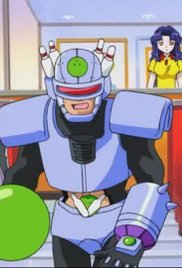
Despite these twists and seemingly diminishing returns, RoboCop never lost his power to affect and awe. Thanks goes to the writing and directing team, but also to Peter Weller, Rob Bottin, and Moni Yakim for making the character believable. The biggest thanks, however, goes to the cast and crew who supported the crazy idea of a cyborg police officer patrolling Motor City. If people like Nancy Allen and Steve Bartlett didn’t commit, the first movie could’ve easily been a terrible, Monty Pythonesque production.
One of the main stalwarts of Robo through the years has been RoboCopArchive.com. The Merovingian of all things Alex J. Murphy, it’s an invaluable info hub for the series. But being that makes it also a bit overwhelming to peruse. If only there was a way to streamline that data and absorb it all in one long and entertaining sit. Soon, that wish will be granted. Eastwood Allen, Chris Griffiths, and Gary Smart are part of Cult Screenings UK and are the wishmasters. The company is behind the beyond-fantastic documentaries of HELLRAISER (LEVIATHAN: THE STORY OF HELLRAISER AND HELLBOUND: HELLRAISER II) and FRIGHT NIGHT (YOU’RE SO COOL, BREWSTER!: THE STORY OF FRIGHT NIGHT), with an upcoming one on IT (PENNYWISE: THE STORY OF IT). They also got a fair bit of press for ROBODOC, including a mention on Entertainment Weekly’s site. So it’s an immense honor that they took the time out of their hectic schedule to do an interview for Daily Grindhouse. Let’s rock.
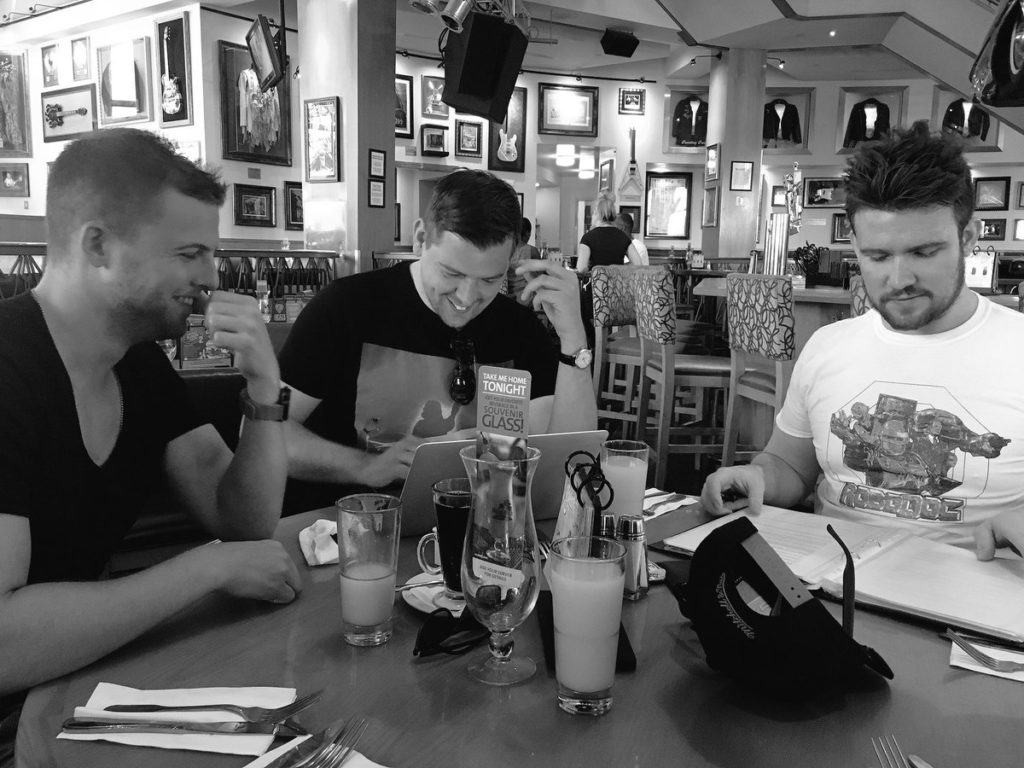
This isn’t your first entry into genre obsession, with books and documentaries about FRIGHT NIGHT, RETURN OF THE LIVING DEAD, AN AMERICAN WEREWOLF IN LONDON, and the first two HELLRAISER films. Nor will this be your last, with PENNYWISE: THE STORY OF IT. What lessons from your previous documentaries did you learn that came in handy with ROBODOC?
Eastwood Allen: We wanted to really cover everything about the RoboCop movies. The team love those movies. Chris and I, especially, have been huge fans of the franchise since kids and have probably seen every doc or featurette out there on the movies. We wanted to cover all essential bases which some fans will likely know, but then go the extra mile and push for other pieces of trivia and unknown stories from the sets. I think knowing how to spark memories in the interviewees comes with experience. It’s often the case that cast & crew members aren’t as close to the franchise as the fans still are. I mean, we’re talking 30 years ago, so it’s important to do your research on things each person may have said at one time in the past and tailor that into the questioning.
Chris Griffiths: As fans of the film’s we produce documentaries for, we realize that no two films are the same. So we try our best to cater for the subject matter. LEVIATHAN was incredibly academic in its approach, and at nine hours long, we were trying to make an entrance into the documentary world. Looking back, with lack of visuals and cutaways, it is quite a chore to get through. But fans love it!
By FRIGHT NIGHT, we had developed our skills and wanted to go for a much faster and more animated pace. So, with the aid of the Peter Vincent segues and the elliptical editing style of Eastwood, we were able to create a far more entertaining piece.
I made the creative call to shoot ROBODOC on green screen. I didn’t feel that shooting in various locations that could potentially look like anything from too sterile to too gothic would be an aesthetic fit for something like RoboCop. So I wanted to try something new, where we could utilize the background for fancy visual elements and keep in tone with the look of the original film.
Gary Smart: The biggest lesson learnt was from LEVIATHAN, and that was to ensure there was a really tight flow to the docs. With LEVIATHAN being our first main venture, we wanted it to be big. Unfortunately at that time, as producer I had very little control over the final edit, and the editors were not huge fans of the genre. That resulted in a very long doc. LEVIATHAN got and still gets great reviews, but one of the main criticisms is the length, and that it’s a lot of talking heads. The biggest change on BREWSTER and ROBODOC was to have editors who were fans of the film and had a real passion for it. In turn, that meant that they knew exactly how to pace interviews and how things fit into it. As producer, I was also more involved in the final edits, and we had many editing meetings to discuss length, pacing, etc. I think that BREWSTER clearly shows the extra effort and hard work that went into the final edit.
With the brilliant works of Laurent Bouzereau, Charles Lauzirika, and Michael Pellerin, long-form documentaries exist with studio releases. Why go the independent route?
GS: The independent route was solely down to us being newbies and trying to prove ourselves in the business. If we had approached a major studio, would we have been taken seriously? I don’t think so, really. Also, being independent allowed us to have creative freedom in making our own choices and stamping out our own style. I’d be more than happy to work with a studio on a project, and I’m still happy to work independently.
The list of interviewees for ROBODOC is massive, though, like Ashley Laurence and LEVIATHAN, a major player sadly chose not to participate. Who was your first interview for ROBODOC, and who was the trickiest success?
EA: I believe the first was Rocco Gioffre, who is just an extraordinary Matte Artist [the one who paints a location to look like anything from the Gates of Mordor to OCP headquarters – RK]. He continues to work on some of the biggest and best shows like GAME OF THRONES. Although, you could count Mark Irwin [a cinematographer, the one who helps the director with what the camera sees – RK]. He answered some ROBOCOP 2 questions when interviewed for FRIGHT NIGHT PART 2 for our other doc, YOU’RE SO COOL, BREWSTER!
As for the trickiest, I’m not too sure. Gary and our production coordinator, Mike Perez, worked their magic on tracking people down. I can say S.D. Nemeth, who played Bixby “I’d Buy That for a Dollar” Snyder was one of the tougher ones to find. He wasn’t on any social media, email, or anything conventional, and was a real gem of a man. I sat with him and showed him just how popular his character had gotten in pop culture. He honestly had no idea that his face was on mugs and T-shirts, or that he’d be parodied over the years. That was a great experience to witness his eyes light up.
CG: Our previous endeavors featured roughly 30-40 people. Thus far, ROBODOC has acquired over 90 people, half of which have never been interviewed on camera before. Our first interview was with Matte Artist, Rocco Gioffre, who really needs no introduction, given the breadth of his work. In terms of trickiest success, it’s a hard one to call as we have managed to locate some of the most unique interviews, from the would-be rape victim to Bixby Snyder himself, S.D. Nemeth.
GS: The question everyone asks us is “Why wasn’t Ashley in LEVIATHAN?” “Why wasn’t Traci Lin in BREWSTER?” And, of course, “Why isn’t Peter Weller in ROBODOC?” The answer for us is easy: “They didn’t want to be!” Now, of course, we are upset. We love these films, and it truly hurts when someone says no, but we have to respect their wishes. There are always reasons why people say no, but if I can tell you that we tried Dr. Weller nine times, it shows you that we tried every avenue. You just need to move on and carry on doing what you’re doing. For us, every person involved in a film’s production is as equal as the other. A Cenobite has limited experiences on set, whereas the clapper loader [the one with the B&W board before someone says “Action!” – RK] was there every day, knows every story. So our docs have always been about promoting the unknown heroes of film. But yeah, at the end of the day, it is upsetting when a big name turns you down.
For ROBODOC, the first interview was with Rocco Gioffre, the Matte Painter. He was a dream come true and had some amazing stories. I’d say the hardest person to get involved was Tom Noonan, just because he was so busy, and we kept missing the opportunity. We got him in the end and he was great!
Rocco’s a great get because of his pedigree as a Matte Painter, including films like BLADE RUNNER. I’m really looking forward to Nancy Allen, because she’s been relatively mum about her time with Robo, and also the sound design team. RoboCop, the character, is equal parts the actor, the suit, and the sound. What they’ll have to say about Cain will be especially intriguing because he still sounds terrifying. I love that your docs also focus on the below-the-line people but I’m curious, was it an organic process or did you decide from the onset to incorporate as many voices as possible?
GS: For me, it all started in LEVIATHAN, having met so many people who had never been interviewed before, yet had so many brilliant stories really showed be that there are so many unsung heroes on films. These people were part of every process in production, and the main thing about creative people is that they remember every detail possible. So, for me, I like to promote the BTS crew who don’t get much recognition and show the fans who they are and how important they are to their beloved movies.
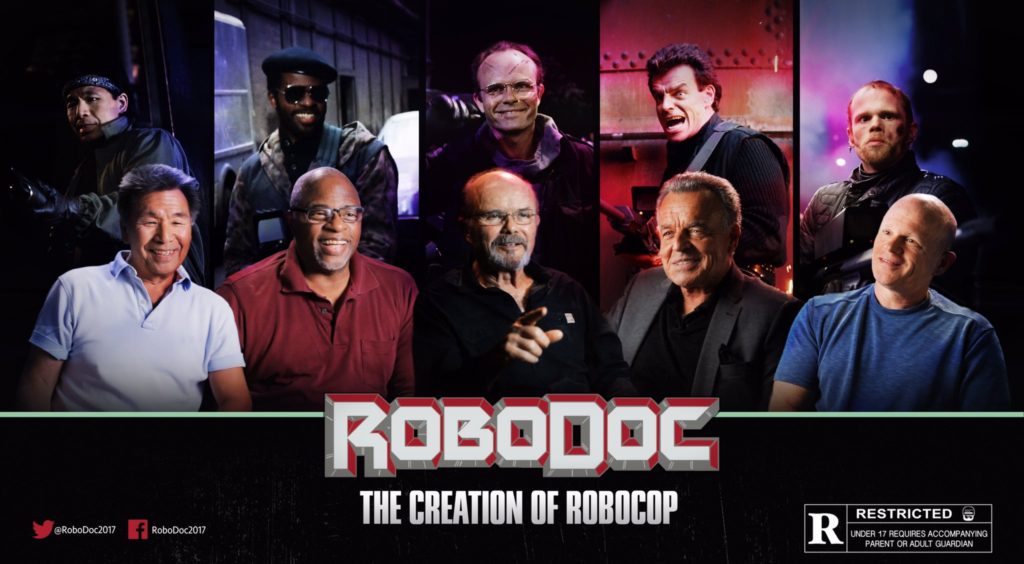
I imagine that wrangling the massive amount of interviewees could be likened to herding cats because people are busy and live in different parts of the world. How does one go about getting interviews?
EA: One of the coolest things about being in LA for the first leg of production was that we’d be talking to one cast or crew member, and they’d put us in touch with their buddies who also worked on the movies, right there from the interview chair. The fastest turn-around was less than 30 minutes in one case, from initial contact to that person being sat down in our green screen studio. We had several moments like that. Gary reached out to Ray Wise on Twitter, and we had him drive down to meet us that very same morning. Technology at its finest, really.
CG: It all depends on the project and the people. We cannot thank those who have been involved with our efforts enough. They all come along to our interviews essentially to appease us fans and also for the love of the subject. We usually make a few connections at the beginning, some of which might link between the films we’ve covered and then send both Gary and production coordinator, Mike Perez, to hunt people down in any way they can. Believe me, it’s a task I’ve had. A few goes at along the way and it is knackering! For the most part, we shoot the interviews ourselves but given people’s work schedules and locations, we subcontract other filmmakers we have worked with. Most recently, we passed the reigns over to our DP [director of photography, A.K.A., the cinematographer – RK], Jerrold Ridenour, who is based in Los Angeles, to continue shooting further interviews with Mike Perez in our absence.
GS: For LEVIATHAN and BREWSTER, I organised all the interviews with the help of our line producer, Adam Evans. LEVIATHAN was more straight forward as many of the cast and crew were known to us and were UK-based. The biggest drawback was that the doc was shot over a 12-month period. Many weekends were spent in hotel conference rooms, interviewing. With BREWSTER, I wanted the production process to be faster, so we planned a three-week interview schedule in the USA. Our biggest asset on BREWSTER was, of course, Tom Holland. Without his help, I don’t think the project could have happened. Tom knew of LEVIATHAN, and we immediately hit it off via email. Tom loves FRIGHT NIGHT and adores his fans, so he was passionate from the get-go about making something special. For ROBODOC, I knew I needed a US-based producer to support with the huge amount of interview scheduling. I had already worked with Michael Perez on MORE BRAINS, and he has a great pedigree within documentaries having worked on NEVER SLEEP AGAIN, CRYSTAL LAKE MEMORIES, SCREAM, and so on. Mikey was a real asset to our production and did a great job — he is very much part of the Dead Mouse family now.
Dick Jones had to kill Bob Morton because he made a mistake, the same feeling could be felt from the production team if something went wrong with the equipment. What kind of equipment did you record and edit with, and how reliable were they?
EA: Most of post is done using the Adobe Suite. It’s incredibly intuitive and ideal for project sharing. You have all the tools you need and it doesn’t break the bank.
CG: Like any typical video producer of this day and age, we shoot our interviews on DSLR cameras and basic audio equipment, with lighting being diffused by a baking sheet on one occasion (true story). For the most part, we have been lucky. It’s only on a few occasions have we had something like a horrific buzz covering Chris Sarandon’s voice as his microphone wire interfered with lighting wires. It was fortunately salvaged by my brother (and Dead Mouse go-to sound guy, Gareth Evans). Or having a B-camera [a camera that shoots at the same time as the main one – RK] fail on us for the FRIGHT NIGHT shoot. Leading us around what felt like the distance of England visiting every secondhand camera shop in Los Angeles in order to repair or replace it. It can easily all go to hell but keep calm and adapt is my thinking.
GS: This is a question for the tech boys Chris and Eastwood. My role is to say “get it done,” and the boys always deliver an high quality product.
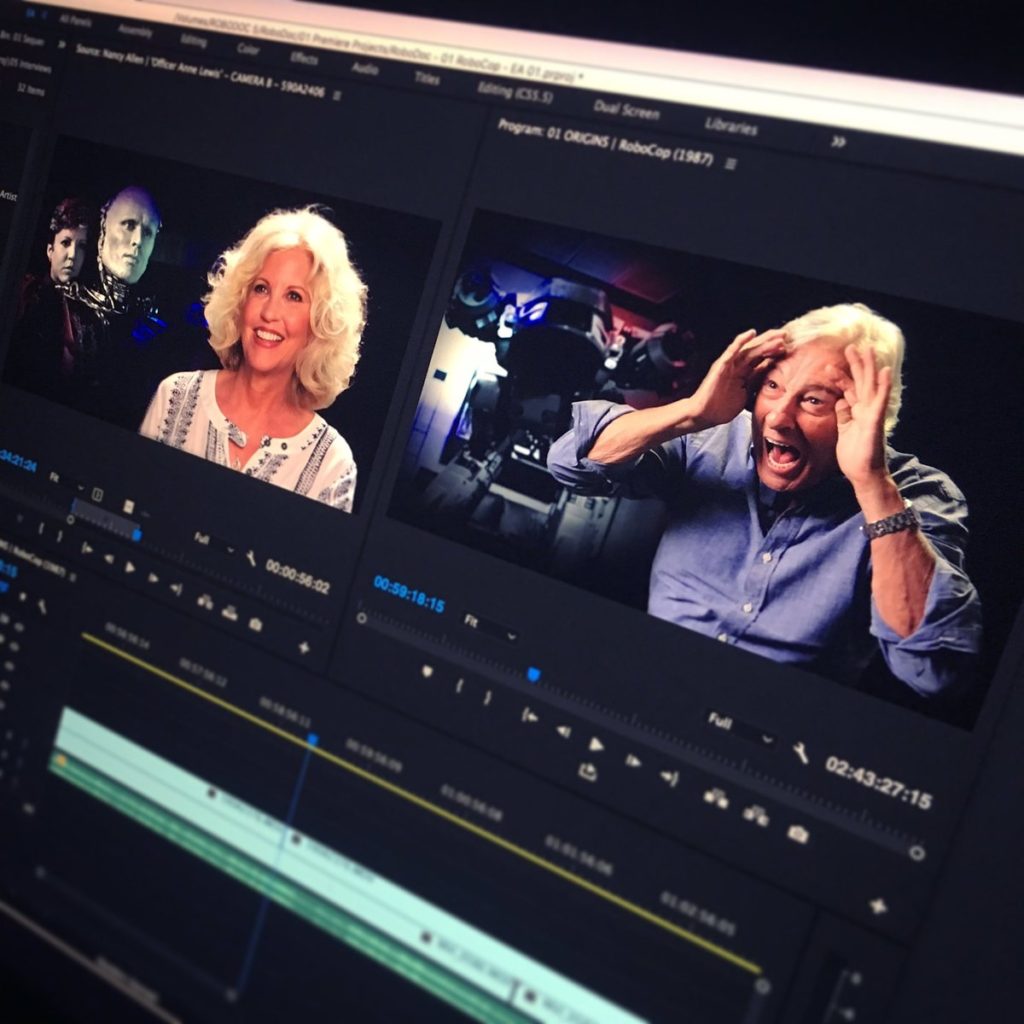
One of the things that fans might not realize is how much work goes into making your documentaries. What’s a typical workday in each phase of production?
CG: The average day lasts approximately 9-10 hours. FRIGHT NIGHT had us travelling in and around Los Angeles to various cast and crew members’ homes or studios. With the size of the place and traffic, we were lucky if we could get three to four interviews in a day.
With ROBODOC, we opted for a studio space to conduct the interviews for the purpose of green screen photography. With that, we were able to conduct anything up to eight interviews a day. Whilst myself, Adam, Eastwood, and DP, Jerrold, were in one room shooting, producer Gary and coordinator Mike would be in the front office trying to obtain as many more people that they could get. Safe to say, their hard work definitely paid off.
We were in the United States for three weeks with ROBODOC, and I do not exaggerate when I say we probably had 3-4 days where we had no commitments in being anywhere. It was incredibly demanding work!
GS: Production days are long, tiring and stressful. We were in the USA for three weeks for ROBODOC and literally had one day off. You get to the studio at 7am, set up, and then wait for the first interviewee. They normally arrive at 9am, and we interview for 1-2 hours. We interview up to five people a day and finish about 6pm, so they are long days. Post-production is a long, long process, and Eastwood and Chris do an amazing job.
Making a documentary is a long, involving process that occupies every aspect of your life until it’s over. How do you unwind after finishing a documentary, and how do you stay motivated while making one?
EA: The production for me was just amazing. We were literally meeting people we had looked up to since we were kids. Since the shoot, I focus primarily on post-production so I live with the footage for a long time. It takes months of work, but ROBODOC is a dream project. It’s not hard to feel motivated and I make a conscious effort to appreciate how cool it is that we get to do this. The hardest task is organising and logging every interview. In this case, 85-90 of them. The ‘admin’ kinda stuff isn’t too fun, but once the project is set and the editing begins, I relish that. The best part of post for me is adding the music, sound design, and motion graphics. Really bringing the content to life. We’ve got so much material. There’s going to be a few surprises for the hardcore fans.
CG: Making these documentaries are incredibly exciting, satisfying, and stressful. Given that all of us hold full-time jobs in other fields, these projects really are a labor of love. Staying motivated is pretty easy when in the projects, as Gary has already committed us to another project during the course of making one! We do this for the love of the game so it’d be very rare that you find one of us trailing behind throughout the course of the production.
GS: As you can see from our products, we don’t stop… as soon as we are in post on one we are in pre-production on another. If it’s not the docs, it’s the books or a special feature for someone else. My mantra is to keep as busy as possible. If we want to break into this industry, then we can’t sit back and wait for it to happen. It’s all about opening the right doors and creating a brand.
The horror genre has many subjects with tales to tell, but you changed gears with this project. What was the thing that made you switch from a horror subject to a sci-fi one, and was the switch freeing or terrifying?
EA: You approach each project the same, really. It’s all in the organisation and planning. I think the production needs a be a little sleeker when tackling a science-fiction project. Horror allow you to be a little more rough and ready aesthetically. That’s why we decided to film the interviewees with green screen, so we have more control on the look, feel, and consistency of style.
CG: We love all genres. It’s just, like many people, we are quite obsessed with horror! On the other hand, ROBOCOP is my all-time favourite movie, and where it essentially all began for me with my love of film. So the prospect of making my mark on this franchise has always been a goal for me. This project also allows us to reach new audiences, who might not be quite as nuts about horror as us as well!!
I don’t think genre is necessarily an issue when it comes to that golden age of film that so many of us look back at through the wavy lines of an overused VHS tape we stole from our parents’ shelves.
GS: I love horror and I really do think that ROBOCOP can fall in to the horror genre. Horror isn’t all about monsters and zombies, it’s about what real people can do, and the lengths that they will go to for power. Take Murphy’s death. That was one of the most horrific death scenes in film. So the switch wasn’t daunting at all. The daunting thing about ROBODOC was the sheer size of it. With now over 90 interviews completed, the doc is one huge beast and will be everything that that fans have been hoping for. I’m very proud of the team, and they work their backsides off for little reward other than making something that they would love to see themselves.
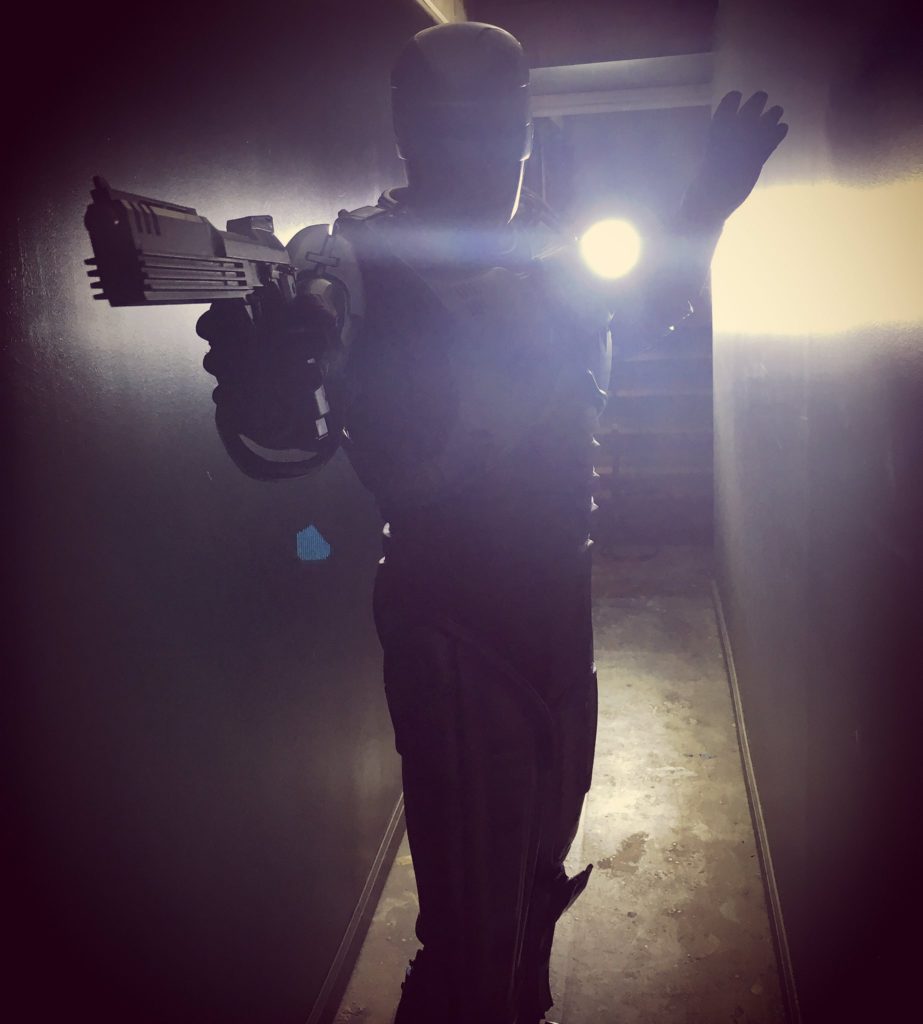
I loved that one of the packaging options for ROBODOC was a VHS box and quickly ordered it. There’s a film distribution company stateside, Criterion, that did something similar with their VIDEODROME release, packaging it in a Betamax cassette. What inspired you to be so geeky and was it difficult to find a company that could make the case?
CG: The films we tend to focus on are from that golden era of VHS and we always try to acknowledge that in some way with our projects. Which can be seen on both the FRIGHT NIGHT and ROBODOC Kickstarter videos. We attend Weekend of Hell in Germany every November, and the market stalls of various Blu-ray and DVD editions of cult movies is insane. We were inspired by their large retro-looking hard cases for certain films, so it made sense we would go down that route.
GS: We had seen these really quirky VHS style Blu-ray boxes in Germany. A lot of companies over there use them so we thought it would look great for ROBODOC. The KS response was really impressive for the alternative box set so we reached out to the company in Germany, and they were happy to produce a limited run for us. They are quite expensive but as a fan, I’d buy one so I think people will dig them.
You have been involved with the creation of two major horror home releases: Arrow Video’s HELLRAISER: THE SCARLET BOX and Scream Factory’s RETURN OF THE LIVING DEAD. How was the scope of your involvement decided with the two releases, and was there any sort of collaboration between you and Red Shirt Pictures when it came to Scream Factory’s ROBOCOP sequel releases?
CG: We were approached by Arrow to participate in the production of the Scarlet Box set just as LEVIATHAN had been released. Given the size of the documentary and logical thinking, we offered them a condensed version of the documentaries. Which I myself cut for their release. Since then, we have done the same with FRIGHT NIGHT for Eureka’s new and stunning release. Along the way, we have had involvement with Scream Factory, shooting an exclusive interview Brian Cox for their MANHUNTER Blu-ray and providing commentaries for RETURN OF THE LIVING DEAD, ROBOCOP 2, and ROBOCOP 3. We did not provide or participate in any documentary content though on those projects.
GS: We had no involvement with Red Shirt at all. They are an amazing company who produce some amazing docs and special features. Unfortunately, being UK-based means we are solely independent. We were in talks with Arrow midway through LEVIATHAN‘s production and at one stage, Arrow was thinking about releasing LEVIATHAN as a stand-alone Blu-ray/DVD set. When they announced the Scarlet Box set, we re-engaged with them and offered them a condensed version of LEVIATHAN as their main special feature. I have a lot of time for the folks at Arrow and have spent many a day with them at conventions having a laugh. Cliff at Scream Factory is also a joy to work with. He first reached out to me about the RETURN OF THE LIVING DEAD release, as he knew I was a huge fan, and somewhat the historian for the film after the book and documentary. I was able to put him together with the producers of MORE BRAINS and provide a commentary for the film with Chris Griffiths. Sine we were friends with the actor Brian Cox, who is also the patron of our company, as soon as we heard that Scream were releasing MANHUNTER, I reached out to Cliff and offered to get Brian on board. That resulted in a fantastic 45-minute bonus feature titled THE FIRST LECKTOR.
The ROBOCOP commentaries came about the same way that the RETURN OF THE LIVING DEAD one did. I was having an email chat with Cliff and I suggested that Chris, Eastwood and I completed a commentary for ROBOCOP 2 and 3. Cliff though it would be a great idea, and the following week, we completed them.
To be honest, we’ve been very fortunate to create some great links in the business who recognize the passion that we have for film.
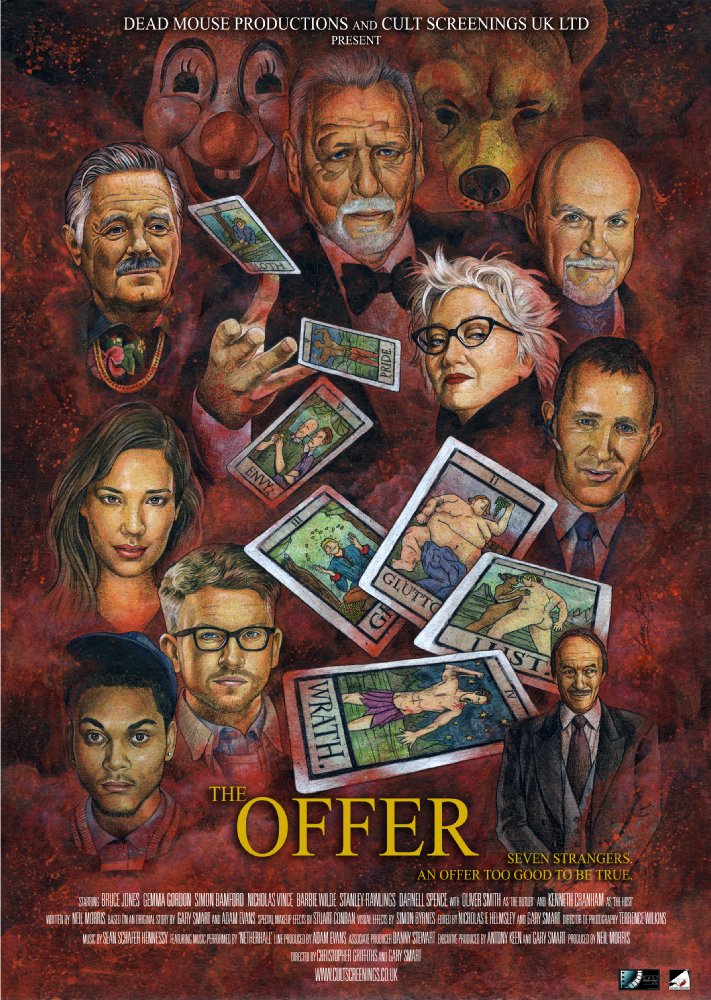
Soon, you’ll be dancing between two worlds, as historians and as history-makers. Tell us about THE OFFER and what it was like to make a film after having spent so much time making films about making films.
CG: We love celebrating our favourite movies and getting to meet those who created them, and we have always had our eye on wanting to produce our own original content. Which is partly the reason we incorporated the Peter Vincent segues and fake trailers on the FRIGHT NIGHT documentary. THE OFFER is an idea by Gary and Adam, which has been scripted by Neil Morris (who wrote the Peter Vincent segments). It was actually dropped on me by surprise, as they were penning it whilst I was co-editing the FRIGHT NIGHT documentary. But now I’m up to speed, acting as director and really relishing in all our accomplishments with a project before it has even been shot. Given the master planning of Gary as producer and bringing together all the necessary elements. We have had the great fortune of inheriting a number of the HELLRAISER cast and crew (Barbie Wilde, Simon Bamford, Nicholas Vince, Oliver Smith, and Ken Cranham, with Stuart Conran providing make-up effects), along with some new talented faces. The tests we’ve made with our director of photography, Terrence Wilkins, look incredible inside the unbelievably picturesque, dilapidated manor house we are shooting at in Lincolnshire. The basic premise is of a group of people being invited to an unknown hosts party to play a game where not all is as it seems. It is very familiar in its basic premise and reminiscent of AN INSPECTOR CALLS, CLUE, and other such movies. But it has its own identity and embarks in its own direction, very much in the same vein as BBC’s INSIDE NO. 9, in being 30 minutes in length.
GS: THE OFFER is my dream project. Right from when I first can remember, I have loved film and wanted to be part of the film world. The docs have been amazing in teaching us about how films are made, the importance of team work, and how a small idea can just grow and grow. I love horror too, and wanted to make something that was both fresh and a homage to some of the classics such as Hammer Horror. THE OFFER takes inspiration from AN INSPECTOR CALLS, CLUE, HOUSE ON HAUNTED HILL, and a number of others. The story is simple: seven strangers have been invited to a now deceased millionaires house in the hope of winning £10,000,000. When they arrive at the house, their host talks to them through a pre-recorded video and invites them all to take part in a game. Once the game starts, each of the guests ends up being killed in an horrific way. There are lots of plot twists, humour and plenty of gore. This project really has been a labour of love. We’ve been lucky to get Kenneth Cranham, Bruce Jones, Barbie Wilde, Nicholas Vince, Simon Bamford, Stuart Conran and Oliver Smith on board, as well as three new-comers. The cast are amazing as is our crew, and our location is a thing of beauty. So we really do have all the right ingredients to make something special.
The intention for THE OFFER is that it is the pilot for a six-part series titled DARK DITTIES. DARK DITTIES is an anthology series comprising of humour and horror, and each story is self-contained. Very much like BLACK MIRROR and INSIDE NO.9. We are really hoping that the powers that be like what they see and want us to do more.
Are people able to view THE OFFER, or is it currently touring festivals and the desks of studio execs?
GS: We actually complete principal photography on 9-13 April, then we have a few SFX pick-up shots, then we’re in edit and composing stages. THE OFFER will then tour festivals and will end up on the desks of the right people. The whole idea of THE OFFER is that it is part of an anthology series titled DARK DITTIES and we already have five other episodes ready to go.
You’ve met so many people in making documentaries and writing books, and can humble-brag about Brian Cox being your patron. Are you immune to being starstruck now?
EA: There definitely was a little tremble or two when stepping into Paul Verhoeven’s house to meet him. Lucky for us we were greeted with so much warmth by his wife, Martine, who was actually directly responsible for ROBOCOP being made with Paul Verhoeven at the helm. The nerves did vanish when she gave us all ice creams from the freezer. Mr. Verhoeven was cool and signed a stack of merchandise, including my original 1989 ROBOCOP VHS tape. That moment was a little surreal.
CG: I don’t think with projects like these I will ever not be starstruck. I just know I’m going to have to stop myself from quoting HOME ALONE 2 when Tim Curry joins us for our IT documentary. It’s more so the case of maintaining your outside cool whilst smiling like a Cheshire cat on the inside. Something I practically failed at when sitting face-to-face with Leland Palmer—sorry, Leon Nash: RAY WISE!
GS: It’s funny as I think that as a fan of these movies I’ll always be starstruck. I’ve managed to meet some of my favorite actors doing these projects, and Brian has been a huge supporter of us for the past few years. I really want to get him involved in one of our film projects. I think I’ll be pretty starstruck when I meet Tim Curry. To me, the man is a legend, and I am so overwhelmed that he agreed to be part of PENNYWISE. The doc really is a tribute to him, too.
What are four things one needs to attempt what you and Cult Screenings UK do, apart from having an immense love for the material to drag you out of the lows and to make the highs sweeter?
GS: I’ve been really lucky to have Adam and Chris on board from day one, and then our team grew to include Neil and Terrence. The biggest thing is that we are all friends too, we each know what our roles are, and what we bring to the table. So if I could sum up the four things to do what we do, they would be:
- Build a great team of individuals that all want the best results and aren’t in it for the money, but in it for the work.
- Choose a project close to your heart, something that you want to do, a project that you would love to see yourself.
- Know your chosen project inside out, do the research and know more than anyone else can know about it.
- Include the right people in your project. As you expand you’ll need more help, find those people, network and seek expertise that will build your team and make your next project even better.
The most important question on this list: Could Peter Weller’s RoboCop beat the Terminator?
EA: I guess the comics would certainly tell you “YES! Peter Weller’s Robo would win.” I like the notion that he’s the gunslinging-hero, but if there was such a reality, I think the Terminator would take him, The T-800 is a lot faster and more agile. Robo also has organics and can feel pain, so he’s certainly more vulnerable. I always wanted to see what happened if Robo was shot in the exposed fleshy mouth region. I think that visual should have been explored in the movie sequels. I guess it would have been a practical nightmare from a makeup effects perspective. It’d also be pretty horrifying.
CG: I had this very debate with my fiancée not long ago. Naturally, being biased and being a big fan of the old Mega Drive game, I genuinely believe Murphy could outwit the Terminator and use his human instincts to wipe the floor with him. It’s RoboCop!
GS: I’d like to say RoboCop, as he’s been a huge part of my life this last year, but I think it would be the Terminator, as he’s virtually indestructible.
Thanks again to Eastwood, Chris, and Gary for their time and awesome answers. ROBODOC will be available later this year. Be sure to follow them on Twitter (@RoboDoc2017) and Facebook.
And remember: We’ll all float soon…
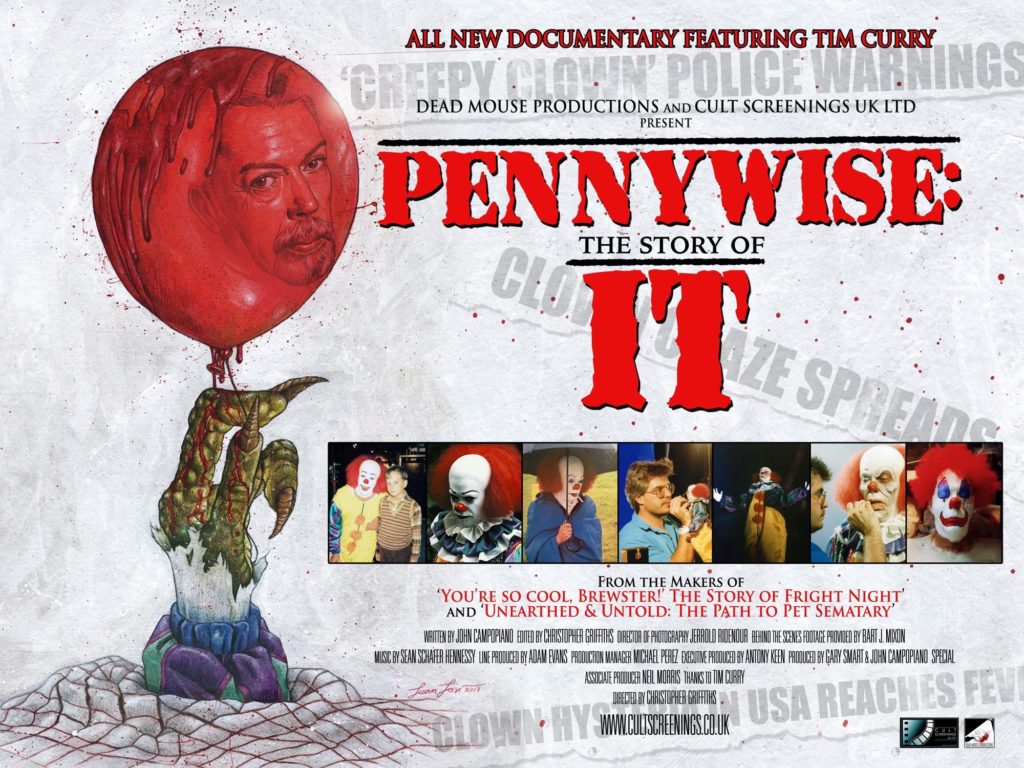
Tags: Brian Cox, Chris Griffiths, Documentaries, Eastwood Allen, Ed Neumeier, Filmmaking, Gary Smart, Interviews, Mark Irwin, Michael Miner, Moni Yakim, nancy allen, Paul Verhoeven, Peter Weller, Ray Wise, Rob Bottin, robocop, Rocco Gioffre, S.D. Nemeth, Steve Bartlett, Tim Curry, Tom Noonan

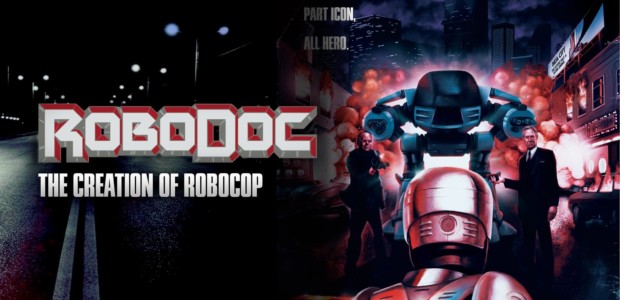
No Comments